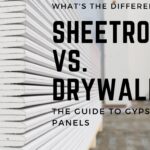If you’re planning a drywall project, chances are you’ve had to do some research on fast drying joint compound. While you may understand what drywall mud does, you might not understand why there are so many choices.
Not only that, but what’s the difference between the products? Let’s clarify what each joint compound is and when to use them.
What is Joint Compound
Joint compound, sometimes referred to as drywall mud or sheetrock mud, is used to cover drywall.
It’s a gypsum-based mix that connects drywall seams and corner beads, provides extra structure, and covers up problem spots for smooth surfaces that are ready for paint.
Professionals may refer to joint compound as Durabond. This is just a specific brand manufactured by USG, the same company that makes Sheetrock Brand drywall.
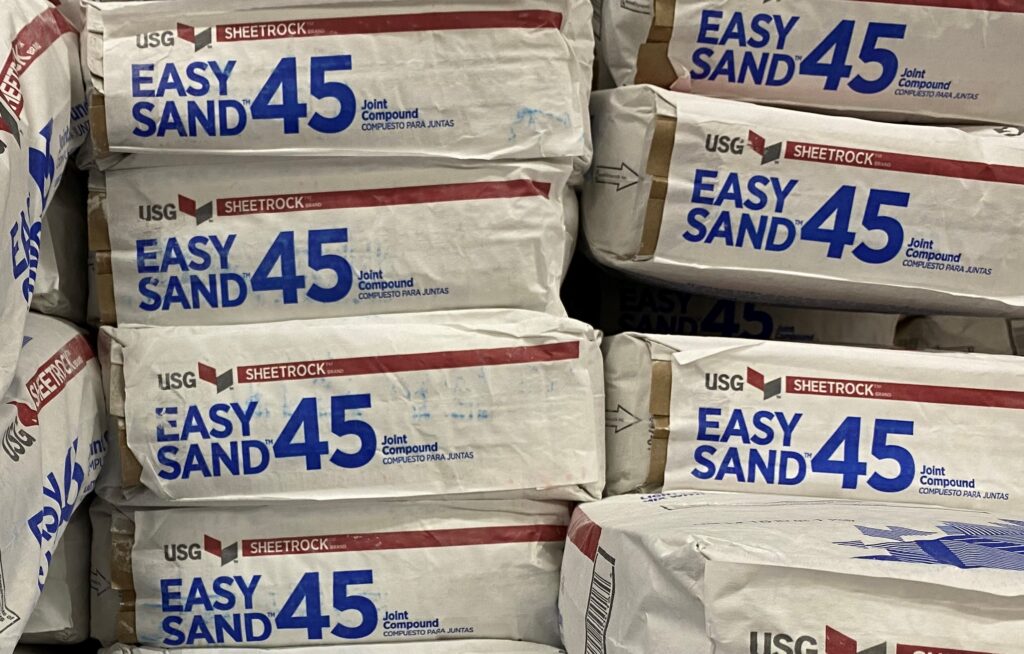
Applying Joint Compound and Drywall Tape
Before we dive into the different types of drywall mud, it’s important to cover drywall tape and the process of taping and mudding drywall.
Joint compound and tape are used on the latter end of the drywalling process.
After drywall has been measured, cut, and fastened to the walls, the seams and screw heads are covered with layers of joint compound and tape to create a smooth and uniform surface.
The Three Coat Process
The process works by applying the first coat of compound, and allowing it to dry and harden. The joints and corners are covered with corner bead and joint tape is applied at the drywall seams.
After the first coat dries, a second coat is applied, followed by a third and final coat.
Each coat has a specific purpose. The first and second coat are focused on coverage, and the thrid coat is focused on smoothness and evenness.
Once the third coat dries it can be sanded down for a smooth finish.
Difference Between Joint Compound and Plaster
Joint compound has been the preferred method of finishing drywall since the early 20th century.
The main difference between drywall mud and plaster of paris products typical in buildings built before the early 1900s is the hardening effects of plaster.
Drywall mud, or hydrated calcium sulfate, forms when the dry powders of drywall mud mix with water.
It’s similar to plaster but lacks the cement-like hardening in the lime and aggregate plaster mix.
Type of Joint Compound
Joint compounds can be broken down into two main categories:
- Fast Drying (AKA Quick Setting or “Hot” mud)
- Premixed Drywall Mud
You can find dozens of different drywall mud in stores with specific uses and branding.
Quick Setting Drywall Mud
Also called hot mud or fast-drying mud, this joint compound is sold in plastic-lined boxes or paper bags in powder form.
The gypsum dust is mixed with water, which starts turning the mud from wet to dry.
There are a few rationales as to why it’s called “hot mud.” The actual chemical reaction that begins once you mix the powder with a little water releases a small amount of heat.
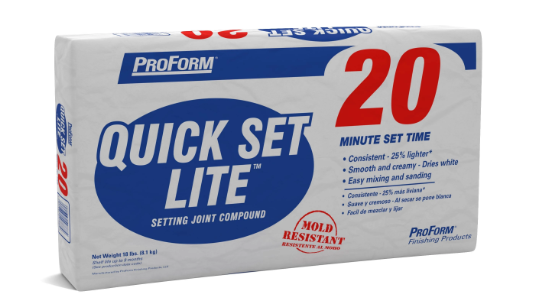
Another is that once you mix water into the product, you have to move quickly, or else it’ll set before you fully apply it.
Either way, it’s important to only mix as much as you need and use it before it sets.
Additional Coats in Less Time
Fast drying joint compound is sold according to drying times which can vary by manufacturer from 90 minutes to 20 minutes. The quicker setting times of hot mud allow you to apply additional coats in less time.
It allows multiple coats on the same day, along with patching or drywall repairs of troublesome spots where drying might otherwise be an issue.
Many professionals think hot mud provides a crack-resistant, strong base coat. The downside is that the quick setting stuff is rarely used as a finish coat since it’s difficult to sand for a smooth finish.
One issue professional tapers and finishers understand is that all joint compound shrink. The amount of shrinkage depends on what type of mud you are applying and a variety of site-specific factors.
USG 20 Minute Easy Sand Joint Compound
Lightweight USG 20 Minute Easy Sand is easy to handle, has low shrinkage, and has superior bond properties.
Great for small patching and laminating drywall. It’s recommended to use mesh tape on joints where quick-setting compound is used.
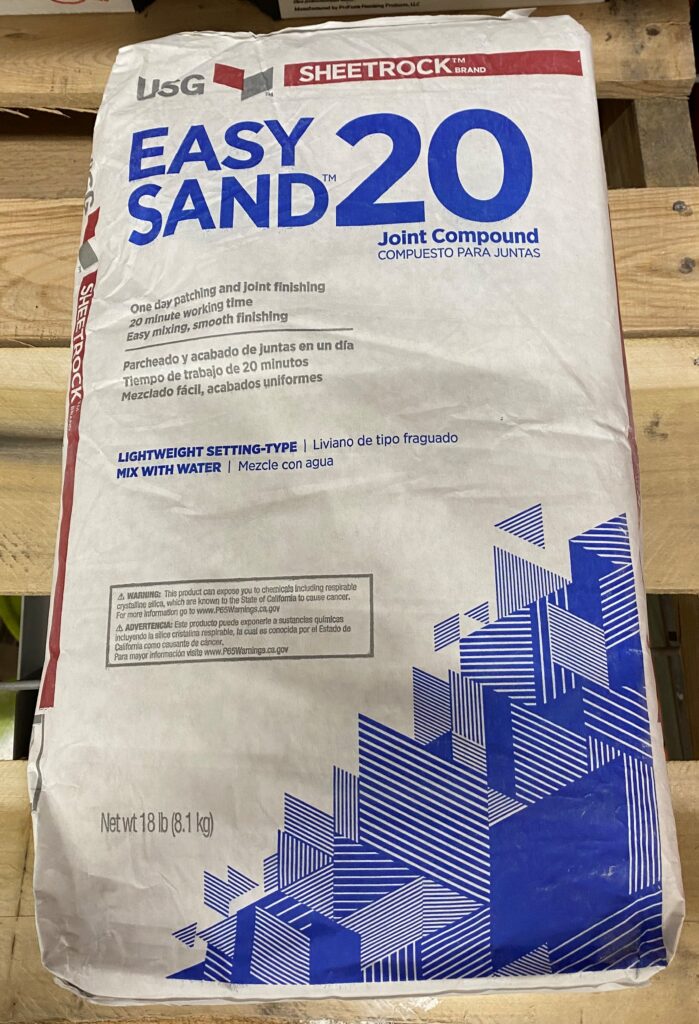
Pre-Mixed Drywall Compound
The premixed regular joint compound is great for convenience’s sake since it’s most commonly sold in 5-gallon buckets.
It’s typically thinned a little with water before applying, but this is what most people think of when they hear the words, “joint compound.”
The trade-off for convenience is that the premixed mud has a longer drying time and can be more expensive.
The most common types of premixed taping compound are All-Purpose, All-Purpose Lightweight, and Topping.
All-Purpose Drywall Compound
All-Purpose joint compound fits it’s name, it really can be used for all purposes. It’s easy to work with and can be used for first coats, embedding tape, small patches, filling nail holes, etc.
The ease of use and universal application make this a favorite for DIYers. However, this regular mud is harder to finish and sand than some others.
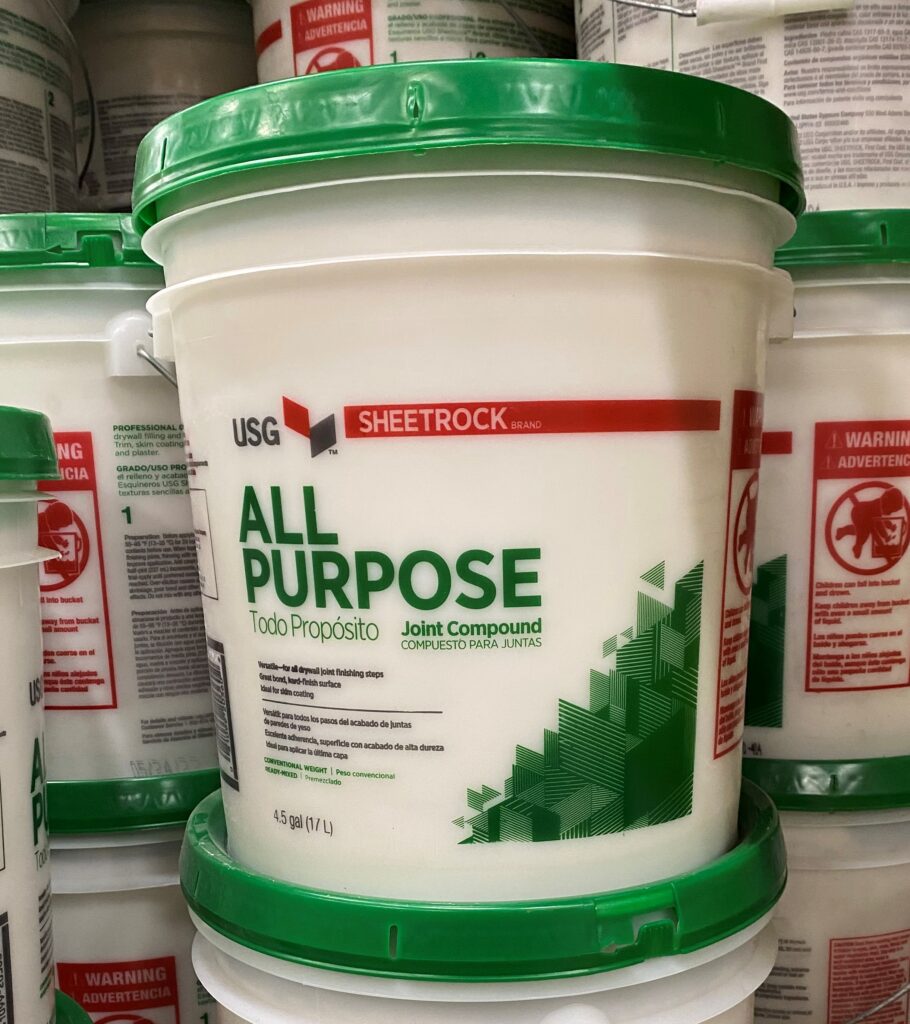
All-Purpose Lightweight Drywall Mud
As the name suggests, this joint compound is a lighter-weight version of the all-purpose.

Some professionals think the lightweight nature means the compound has less binding power and structure than other types of mud.
While it’s hard to pin down the truth, drywall finishing with lightweight mud can be a better choice as a finish coat since it’s easier to sand.
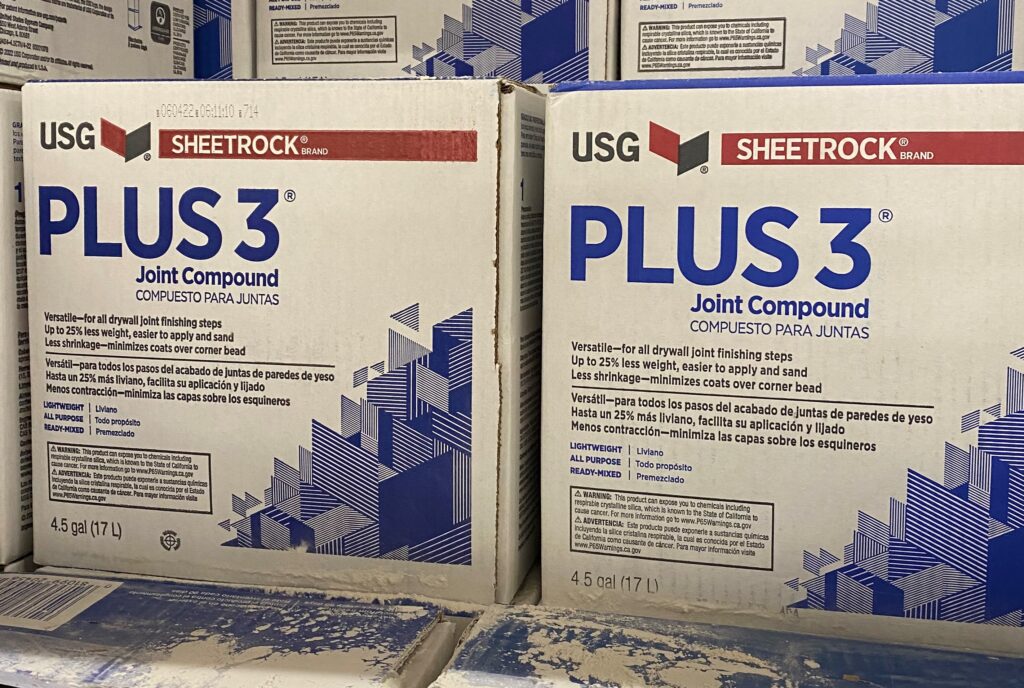
Topping Compound
Topping compound is probably the least used of all the drywall mud on this list. However, it makes for a good finishing coat and is often used for texture applications and skim coating.
This stuff is the whitest of all on the list and has less shrinkage in the drying process than the others.
READ more about common drywall partition types –
When to Use Fast Drying Joint Compound
As mentioned above, the setting and drying times of joint compound are probably the most significant factors to consider when choosing whether to use fast drying or pre-mixed.
The pre-mixed compound is convenient and can be used for multiple coats, but the process may take multiple days. Hot mud can expedite the whole process but requires quick application and taping.
Note that for all types of joint compound, setting and drying times can vary according to the environment. Humid environments can delay drying times significantly, as can cold temperatures.
Dry Times Dependent on Jobsite Environment
When using pre-mixed compound, you can speed up the drying process by applying thinner instead of thicker coats.
Also, the use of space heaters, hair dryer, or heat gun pointed at the freshly applied mud will speed up dry times.
Often, it comes down to personal preference as to how much time is available to finish the project. A project requiring faster drying is usually on a strict schedule for painters to start as soon as possible.
Industry veterans will be all-to-familiar with the request for painters to start before the taping is allocated proper drying times.
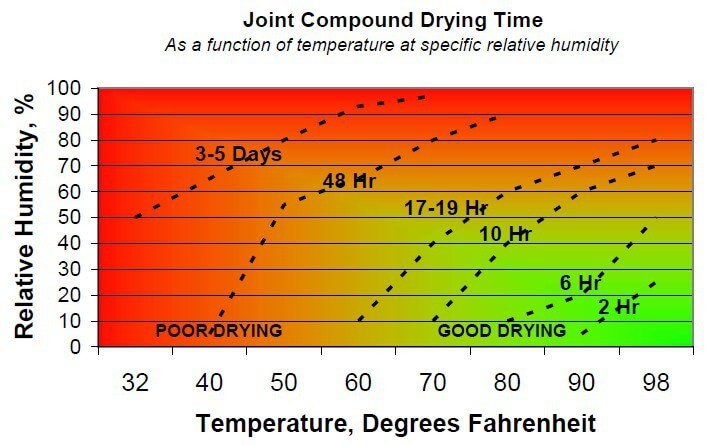
Fast Drying Drywall Compound – Choose Wisely
Use fast drying compound for quick applications, small areas, problem patches, gouges, small holes, and sturdy first coats.
Use all-purpose pre-mixed versions for larger jobs or a large area, and second and finish coats, generally.
When it comes to mixing and matching joint compounds, follow manufacturer instructions.
Most drywall mud is compatible with each other, but it’s best practice to check the manufacturer’s recommendations for compatibility.
What is the Fastest Drying Joint Compound?
- USG Easy Sand – 5 Minute Dry Time
- ProForm Quick Set Lite – 5 Minute Dry Time
- DAP Fast Dry Premium Spackling – 15 Minute Dry Time
- Gorilla Heavy Duty Wall Repair Spackle – 15 Minute Dry Time
- USG Easy Sand – 20 Minute Dry Time
- DAP Fast Patch Compound Powder – 30 Minute Dry Time
- USG Easy Sand – 45 Minute Dry Time
- USG DuraBond – 90 Minute Dry Time

How to Get Joint Compound to Dry Faster
When you’re in a pinch and need to get the paint on the wall, there are a few tricks to dry your drywall mud just a bit faster than normal.
- Use Thinner Coats of Mud – Apply each coat with plenty of pressure on the trowel to not leave extra mud on the wall. Remove all excess mud from the wall and return it to the mud pan.
- Use a Dehumidifier – Pulling the moisture out of the air, and out of the drywall mud on the wall, will definitely help dry the mud faster.
- Use Hot Mud – Fast drying mud is specifically formulated for quick setting times. Even though hot mud is much tougher to work with, and not for beginners, it will absolutely dry faster than regular mud.
- Use a Drying Gun – Blowing dry heat on drywall mud will help it dry faster. Drying guns made specifically for drywall, or even a hair dryer, will help mud dry faster.
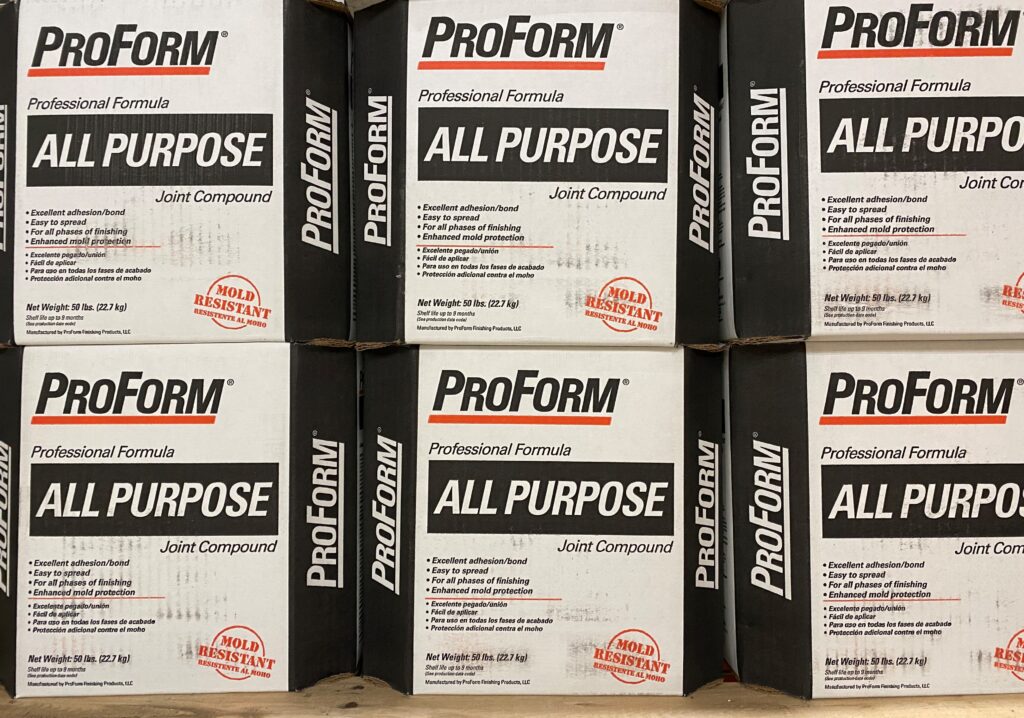
Joint Compound Vs. Spackle
Spackle is used for small dents, dings, and holes in drywall and dries fast, sometimes within 15 minutes. It’s great for small home improvement projects and touch-ups.
When you’re ready to paint drywall repairs quickly, spackle can be the best option. Some spackle brands, such as “DAP,” offer a fast dry product that doesn’t shrink or crack and requires only one coat.
READ more about drywall products for your next project –
DensShield Tile Backer For Your Next Project
Sheetrock Vs Drywall: The Guide To Gypsum Panels
Basics Of Sheetrock Screws And Drywall Screws
Additional Resources –
Current Fast Drying Joint Compound Prices – Home Depot
Current Fast Drying Joint Compound Prices – Menards
Joint Compound Under Extreme Weather Conditions – Gypsum Association (Free Download)
Levels of Finish for Gypsum Panel Products – American Gypsum



